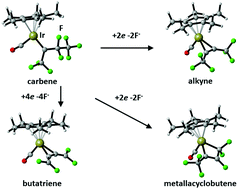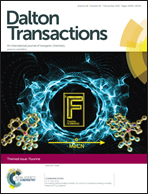A (pentafluoroethyl)(trifluoromethyl)carbene complex of iridium and reductive activation of its sp3 α, β, and γ carbon–fluorine bonds to give perfluoro-2-butyne, perfluoro-1,2,3-butatriene and perfluoro-1-irida-2-methyl-2-cyclobutene) complexes†
Abstract
The (pentafluoroethyl)(trifluoromethyl)carbene complex Cp*Ir(CO)[![[double bond, length as m-dash]](https://www.rsc.org/images/entities/char_e001.gif) C(CF3)(C2F5)] was synthesized by the reductive activation of the α-C–F bond in the perfluoro-sec-butyl-iridium complex Cp*Ir(CO)[CF(CF3)(C2F5)](I) with Na/Pb alloy. This compound exists as two geometric isomers in solution; the structure of one isomer has been determined by a single crystal X-ray diffraction study and contains two independent molecules in the asymmetric unit. Further reduction of this carbene complex with Na/Pb alloy afforded the perfluoro-2-butyne iridium complex Cp*Ir(CO)(η2-CF3C
C(CF3)(C2F5)] was synthesized by the reductive activation of the α-C–F bond in the perfluoro-sec-butyl-iridium complex Cp*Ir(CO)[CF(CF3)(C2F5)](I) with Na/Pb alloy. This compound exists as two geometric isomers in solution; the structure of one isomer has been determined by a single crystal X-ray diffraction study and contains two independent molecules in the asymmetric unit. Further reduction of this carbene complex with Na/Pb alloy afforded the perfluoro-2-butyne iridium complex Cp*Ir(CO)(η2-CF3C![[triple bond, length as m-dash]](https://www.rsc.org/images/entities/char_e002.gif) CCF3) by an overall 2-electron reduction and elimination of two β-fluorides. When magnesium graphite was utilized as the reducing agent for the further reduction, Cp*Ir(CO)(η2-CF3C
CCF3) by an overall 2-electron reduction and elimination of two β-fluorides. When magnesium graphite was utilized as the reducing agent for the further reduction, Cp*Ir(CO)(η2-CF3C![[triple bond, length as m-dash]](https://www.rsc.org/images/entities/char_e002.gif) CCF3) was produced as a minor product and the major product was the perfluoroiridacyclobutene complex Cp*Ir(CO)(η2,4-CF3CCFCF2) resulting from a γ-C–F bond activation. Direct reduction of the precursor Cp*Ir(CO)[CF(CF3)(C2F5)](I) with magnesium graphite generated the tetrafluorobutatriene iridium complex Cp*Ir(CO)(η2,3-CF2
CCF3) was produced as a minor product and the major product was the perfluoroiridacyclobutene complex Cp*Ir(CO)(η2,4-CF3CCFCF2) resulting from a γ-C–F bond activation. Direct reduction of the precursor Cp*Ir(CO)[CF(CF3)(C2F5)](I) with magnesium graphite generated the tetrafluorobutatriene iridium complex Cp*Ir(CO)(η2,3-CF2![[double bond, length as m-dash]](https://www.rsc.org/images/entities/char_e001.gif) C
C![[double bond, length as m-dash]](https://www.rsc.org/images/entities/char_e001.gif) C
C![[double bond, length as m-dash]](https://www.rsc.org/images/entities/char_e001.gif) CF2) along with the perfluoro-2-butyne complex and perfluoroiridacyclobutene complexes in a ratio of 1 : 2 : 6. These reductive inner-sphere pathways to unsaturated fluorocarbon ligands illustrate that carbon–fluorine bond activation can take place at α-, β- and γ-carbons but that selectivity in these heterogeneous reductions is difficult to control, with a variety of fluoride eliminations possible for complex perfluoroalkyl ligands. Density Functional Theory (DFT/B3LYP-D3/LACV3P**++) is used to explore the relative energetics of products and intermediates in these reactions.
CF2) along with the perfluoro-2-butyne complex and perfluoroiridacyclobutene complexes in a ratio of 1 : 2 : 6. These reductive inner-sphere pathways to unsaturated fluorocarbon ligands illustrate that carbon–fluorine bond activation can take place at α-, β- and γ-carbons but that selectivity in these heterogeneous reductions is difficult to control, with a variety of fluoride eliminations possible for complex perfluoroalkyl ligands. Density Functional Theory (DFT/B3LYP-D3/LACV3P**++) is used to explore the relative energetics of products and intermediates in these reactions.

- This article is part of the themed collection: Fluorine

 Please wait while we load your content...
Please wait while we load your content...